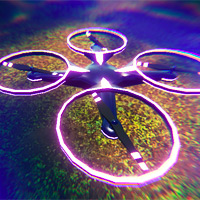
The pitch is defined as how far forward the propeller will move in one revolution. For example, if you have a 5 x 4.5 x 3, then you have a 5 inch propeller, with a 4.5’’ pitch, with a total of 3 blades. Propellers are rated in terms of size, blade number, and blade pitch. There are many, many different styles and sizes of props out there, all made with different materials, different blade pitch, different blade shapes, and different number of blades. Attached directly to the motors via the motor shaft, they spin just as fast as the motors do. Propellers, or props, provide the thrust of the flight system. Read more about FPV Multirotor Drone Motors here. This would be the maximum RPM under no load, meaning with no propeller attached. Take the Kv rating of 2450 and multiply it by 14.8, giving you an RPM of 36,260. If you are running a 4 cell battery, the nominal voltage would be 14.8 volts. The 06 stands for the height of the motor housing in millimeters. As an example, if you have a 2206 – 2450kv motor (a very common motor for 5” multirotors), here’s how it breaks down the 22 stands for the diameter of the motor, the length in millimeters around the outside of the motor housing. Motors are rated by two size numbers allowing you to pick the size you need for your multirotor, as well as the Kv rating, which is defined as the RPM of the motor per volt. These motors have been used in model aviation for many years, and are the components that draw the most power from your system. While relatively small, brushless motors are fairly powerful. Most motors for multirotors are classified as brushless motors, and work by using three phase power to drive electromagnets that spin the motor. Motors provide the power that puts your multirotor into the air. Read more about FPV Multirotor Drone Flight Controllers here. It will basically only exert influence to maintain the position of the multirotor as the pilot has commanded. Most pilots who fly FPV however fly in a mode called “Acro” which does not allow the FC to control the quad beyond user inputs. You can also determine how much control you want to give your flight controller over the multirotor, such as allowing it to auto level your quad when not given a command. Flight controllers are complex pieces of equipment that can be programmed to varying degrees to essentially tune your quad just like you would a racecar. Built into the FC are sensors that tell the onboard firmware the orientation of the multirotor, and also takes in input from the pilot and using the two sets of data, sends commands to the motors to move the multirotor as commanded. The flight controller is essentially the brains of your multirotor, and is easily the most complex component of the flight system. Read more about FPV Multirotor Drone Frames here. This is something to keep in mind when selecting your frame. While you COULD do both with any kind of frame, the performance will often be biased toward one. Frames are often designed with a specific purpose in mind, either racing, or freestyle. It will also give you some insight into how big a propeller the frame is meant for (most frames will let you know what size prop it is designed for). This will give you some general information about how big the overall frame will be so you know what to expect. Frames are measured in millimeters, not from front to back, but diagonally from center of the motor mount on one arm, to the center of the motor mount on the arm directly diagonal from it. There are hundreds of frame designs out there, and many pilots create their own custom frames that fit their individual flying styles. This is what all your components will mount to, and will ultimately dictate what the multirotor will look like. The more thrust you provide the faster the multirotor will gain altitude, and the roll and pitch effectively change what direction is truly up.įrames are the backbone, the skeleton of your multirotor.

Yaw is generally used to change your heading, or the direction your multirotor is facing. When you pitch forward the multirotor will start to move forward, and when you pitch back, it will move backward. Now, when you start to combine roll with thrust, your multirotor will shift either left or right.

Last, again, keep your palm face down, and lift your hand higher in the air then bring it back down, there is your thrust. Keeping your hand palm down, turn your hand left then right, that’s an example of yaw. Now, tip your hand forward, then backward, that would be pitch. Rock your hand from side to side, that is your roll. Hold your hand out in front of you palm down. Let’s start with an exercise to show each of these controls. A multirotor has four control points roll, pitch, yaw, and thrust, and each of these work both independently from one another and can work together to create more complex movement.


 0 kommentar(er)
0 kommentar(er)
